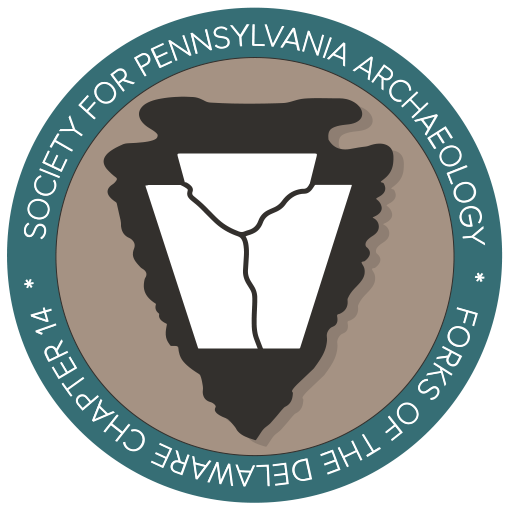By Doris Freyermuth
On May 25-26, 1962, the annual meeting of the Society for Pennsylvania Archaeology was to be held in Wilkes Barre, PA at Wilkes College. It was to be hosted by the Frances Dorrance Chapter 11. The State Organization had sent out invitations to their members to attend with an enclosed program of the conference and seminar. Elinor Fehr , H. Ben and Doris Freyermuth, being members of the state organization for about five years decided that this would be a golden opportunity, not only to sit in on some very interesting papers, but to see and meet the archaeologists that wrote so many of the publications that were in their libraries.
While driving to Wilkes Barre, there was much excitement with the anticipation of meeting the idols of our new and fascinating interest. We were not for one moment disappointed, for some that were attending were:
Dr, Jacob Gruber, Temple University
Dr. Charles Holzinger, Franklin and Marshall
Dr. Fred Kinsey, Pennsylvania Historical Museum Community
Dr. William A. Richie, New York State Museum and Science Service
Dr. Don W. Dragoo, Carnegie Museum
Dr. John Cotter, University of Pennsylvania
Dr. J. Alden Mason, Founder of SPA
Miss Frances Dorence, Founder of SPAThe first day of the annual meeting was so enlightening and enjoyable that we decided to stay over until Sunday and visit the Schacht site. The members of the Frances Dorrance chapter had been excavating a rich and important fortified Indian Town of the Late Prehistoric period for several years. They named the site after the two brothers, Bob and Ed Schacht, who discovered the site. The host chapter invited members of the SPA to dig there on Sunday if they cared to. Elinor Fehr, Ben and Doris Freyermuth, with Bill Stromheier, were assigned to a ten foot square where the topsoil had been removed. The four of them excavated with trowels several inches down into the soil and the artifacts in situ for mapping and recording. This way their first experience with an organized archaeological dig. The weekend in Wilkes Barre had taken three Indian relic hunters and covered them into students of archaeology with the hopes and desires to make the contributions in that science field. Returning home late Sunday afternoon, there were three very happy and excited people with a mutual dream of forming a local chapter of the SPA in the Lehigh Valley area. The dream became reality about six months later when Vincent Mrozoske, Secretary Treasurer of the state society sent out a notice on September 21, 1962 to members within the local chapter that the first meeting to form a chapter would be held at the Northamton County Historical and Geneological Society in September 27th. Mr. Mrozoski was our first speaker that evening. Mr. Mrozoski was the one person from the state organization that was most responsible for the support and help in organizing the Chapter 14.
There were about twenty people at the first meeting and all were in favor of the local chapter. They decided on a name and the meeting to be held monthly. Before the group really organized, Chapter 14 was asked to examine a field south of Kintnersville, along the Delaware River. A front-end loader had picked up a skull while loading for sand for the Bethelhem Steel to be used to cool castings. It was presumed to be prehistoric. Eventually, sixteen burials were removed for the former Sam Overpeck farm and many artifacts were recovered. A hundred square foot area was excavated. On May 25, 1963, at the state meeting at Beaver Falls, a petition was presented to the State Board of Directors, signed by the Chapter Members. A charter was issued by the state to Chapter 14. Chapter 14 has hosted state meetings in 1968 at the Lafayatte College, 1975 at East Stroudsburg University, 1979 at Moravian College, 1986 at Ressica Falls Boy Scouts Reservation an in 2001 Tannersville, PA, 2007, Allentown PA. and (chapter #14 along with chapter #31) 2015, Bethlehem, PA.
Why was the chapter organized?
The Forks of Delaware Chapter 14 of the Society for Pennsylvania Archaeology was organized on September 27, 1962 to promote the study of archaeology, both prehistoric and historic as represented in the Commonwealth of Pennsylvania, to encourage careful scientific research and excavation in the field and to discourage careless and misdirected digging, to promote the conservation and preservation and further the passage of laws prescribing such, to oppose the manufacture and sale of fraudulent antiquities, to encourage the establishment of local archaeological museums and organizations, to promote the spread of archaeological knowledge by means of meetings, publications and desirable publicity, to perpetuate and preserve Native Americans and Colonial place-names, and to serve as a bond between the individual archaeologist, collector and student.
What are the Chapter objectives?
We share the same objectives of the Society for Pennsylvania Archaeology:
- The study of the archaeology of Pennsylvania and neighboring states.
The careful preservation and cataloging of all archaeological sites and artifacts. - The encouragement of the spreading of archaeological knowledge through educational programs.
- The insistence that all members make an honest effort to study the scientific approach to archaeological methods.
- To serve as a bond between individual archaeologist in the area, both non-professional and professional.
- To act in cooperation with the State Society, local historical societies, etc. and render any aid possible.

Hi, this is a comment.
To get started with moderating, editing, and deleting comments, please visit the Comments screen in the dashboard.
Commenter avatars come from Gravatar.
Comments are closed.